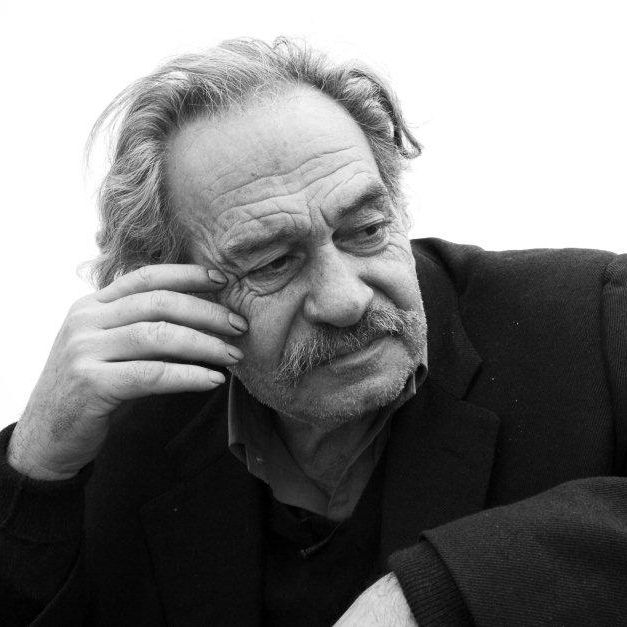Jannis Kounellis
“Everything I do is painting, even if I don’t touch a brush. I tell my truth as a painter.”
A central figure of the Arte Povera movement, Jannis Kounellis forged a practice that transcended the bounds of medium, conferring lyricism to quotidian materials and experiences. Over five decades, he integrated painting, sculpture, found objects, performance, and installation in works that invoke rich sensory stimulation and reflect critically on nature, culture, and economics. Across media, Kounellis worked in the painterly tradition, but with an aim to shed the canvas and examine the intersection of art and life.
Born in Piraeus, Greece, Kounellis moved in 1956 to Rome, where he would live for the rest of his life. He studied at the Accademia di Belle Arti, and, in 1960, he mounted his first solo exhibition at Rome’s Galleria La Tartaruga. Influenced by Alberto Burri and Lucio Fontana, he sought to push painting into new realms. His early work, proto-Pop canvases called “phonetic poems,” feature stenciled letters, numerals, and reproduced street signage. By 1963, he was incorporating found elements, including accumulations of seeds, wool, and burlap, and, by 1966, he had introduced such radical materials as flames, smoke, soot, gold, and coffee grounds. He participated in the seminal 1967 exhibition Arte Povera – e IM Spazio at Galleria La Bertesca, Genoa, curated by Germano Celant, who named the eponymous movement of anti-capitalist, conceptual work that ushered detritus into the space of art. At the end of the 1960s, Kounellis’s installations established a dialogue between the instability and temporal nature of organic materials (including live animals) and the artificiality and permanence of industrial materials. In 1969, he tethered a dozen horses in Galleria L’Attico, Rome, and began blocking gallery doorways with stacks of stones. His work in the following decades increasingly involved performance, and he expanded his vocabulary of materials to include shelving units, trolleys, boats, and musical instruments. His late work explored architectural and urban spaces, as well as his Greco-Roman heritage, with arrangements of cast plaster masks and fragments of classical statues.
In 1972, Kounellis’s first solo exhibition in New York was held at Sonnabend Gallery. He participated in multiple iterations of the Venice Biennale (1972, 1976, 1978, 1980, 1984, 1988, 1993, 2011, 2015) and Documenta, Kassel (1972, 1977, 1982). In 1994, Kounellis presented Ionion, a survey of his work displayed on a boat docked in his native town, Piraeus. Major retrospectives of his work have been organized by such venues as the Museum of Contemporary Art, Chicago (1986, traveled to Musée d’Art Contemporain, Montreal); Museo Madre, Naples (2006); Neue National Galerie, Berlin (2007); Fondazione Prada, Venice (2019); and Walker Art Center, Minneapolis (2022, traveled to Museo Jumex, Mexico City); among numerous others.
Selected Artworks
- Jannis Kounellis
- Untitled (Hair), 2004
- Steel panel and hair mounted in metal case with glass
- 25³⁄₁₆ × 17½ × 5⅛ inches (64 × 44.5 × 13 cm)
- Edition 18 of 25
- Jannis Kounellis
- Untitled (Scissors), 2004
- Sheet of glass, steel shelf, and scissors mounted in metal case with glass
- 25⁹⁄₁₆ × 17¹¹⁄₁₆ × 3¹⁵⁄₁₆ inches (65 × 45 × 10 cm)
- Edition 1 of 25
- Jannis Kounellis
- Untitled (Hanging Knife), 1991
- Etching on paper, hook, and knife mounted in metal case with glass
- 25⁹⁄₁₆ × 17¹¹⁄₁₆ × 3¹⁵⁄₁₆ inches (65 × 45 × 10 cm)
- Edition 14 of 25
- Jannis Kounellis
- Untitled (Coffee), 1989-91
- Etching on paper, coffee beans, and lead mounted in metal case with glass
- 25¹¹⁄₁₆ × 17¹⁵⁄₁₆ × 2¹³⁄₁₆ inches (65.3 × 45.5 × 7.2 cm)
- Edition 15 of 25
